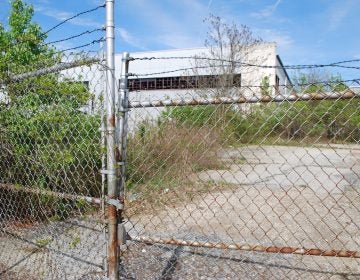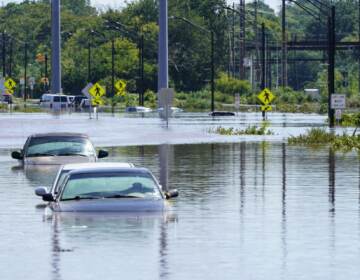Report shows how more Pennsylvania drivers can go electric
Of the 8 million vehicles registered in Pennsylvania, just 15,000 of them are electric.

Sarah Olexsak manages transportation electrification for Pittsburgh-based Duquesne Light. (Amy Sisk/StateImpact Pennsylvania)
This story originally appeared on StateImpact Pennsylvania.
—
Of the 8 million vehicles registered in Pennsylvania, just 15,000 of them are electric.
The Department of Environmental Protection has released a plan several years in the making that outlines how the state can boost that number. Education is a key component.
“There’s not enough information or not enough being done to let people know what vehicles are available, where to go to get those vehicles to test drive them, where the infrastructure is, how the infrastructure works, and the benefits,” said Rick Price, executive director of the nonprofit Pittsburgh Region Clean Cities.
Price is part of a coalition of state officials, clean transportation advocates and businesses that helped develop the plan. It coincides with the state’s climate change goals, including a recent announcement by Gov. Tom Wolf that he wants Pennsylvania’s greenhouse gas emissions to drop 80 percent by 2050. The transportation sector contributes 20 percent of the state’s greenhouse gas emissions.
Secretary Patrick McDonnell, who heads the DEP, said better outreach is necessary to the public, and to auto dealers, who can inform customers about the state’s financial incentives for clean vehicles.
McDonnell said one of the biggest barriers that prevent residents from buying electric cars is a lack of confidence that drivers will be able to find a charging station if they run low on power during a road trip.
“With any alternative fuel, we have the chicken and egg issue,” he said. “Do you buy the car first, or do you make sure the infrastructure is there? We need to make sure we are moving the infrastructure along with the markets.”
Pennsylvania has 400 charging stations, with the vast majority in the Philadelphia and Pittsburgh areas. The report says leading electric vehicle markets have 275 plugs per million people, yet Pennsylvania lags behind at just 43 per million residents.
The state has taken some recent steps to bridge that gap. Its Driving PA Forward initiative uses money from a settlement with Volkswagen to replace or retrofit diesel engines. One part of the program offers grants to help cover the cost of installing charging stations. That’s in addition to another grant program for installing alternative fuel infrastructure, including stations for vehicles that run on electricity, propane or compressed natural gas.
The plan suggests other steps officials could take, like working with utilities to develop financing options or updating building codes to have new facilities install wiring for charging stations. Some options would require action by the Legislature or state regulators.
Now that the report is out, Price hopes to expand upon his group’s existing outreach efforts. He said the coalition will update its website, driveelectricpa.org, to make it a “one-stop shop” for information about electric vehicles.
Then, he hopes to hold events throughout the state to bring in speakers. Plus, they would give people a chance to test-drive electric vehicles.
“The hardest thing to get used to is the quietness,” he said with a laugh.
The report foresees one issue the state will run into if far more drivers go electric: a drop in gasoline tax revenue. That money funds road and bridge maintenance.
“It is something we and a number of other states are going to have to wrestle with going forward, as we see some dramatic shifts over the next 10, 20 years,” McDonnell said.
WHYY is your source for fact-based, in-depth journalism and information. As a nonprofit organization, we rely on financial support from readers like you. Please give today.




